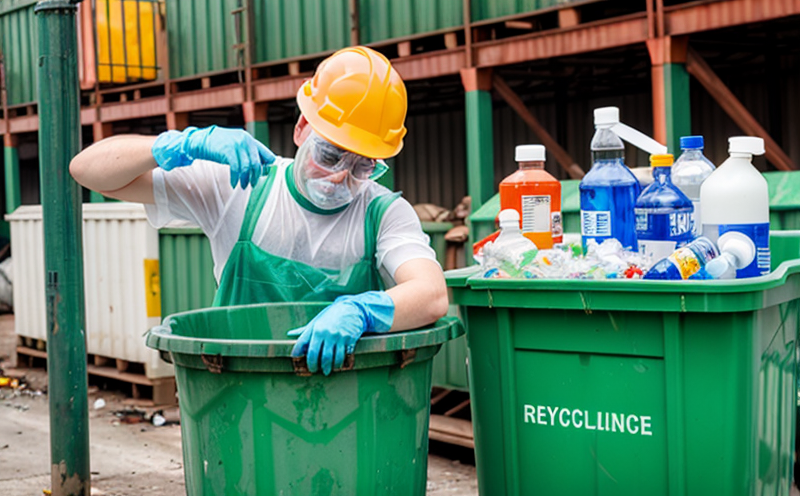EN 12457 Leaching Testing of Solid Waste
The European Standard EN 12457 outlines a method for determining the leachability of hazardous substances from solid waste materials. This test is crucial in evaluating the potential environmental impact that waste can have on soil, water bodies, and groundwater when improperly managed or disposed of.
Leaching refers to the process by which soluble constituents are released into surrounding media due to contact with moisture. The EN 12457 method simulates this scenario in a controlled laboratory setting to assess how different waste materials interact with water under various conditions. This helps ensure that wastes are managed safely and responsibly, minimizing risks to human health and the environment.
The test is particularly important for industries dealing with hazardous or special waste, such as pharmaceutical manufacturers, chemical producers, electronics manufacturers, and those involved in recycling processes. Compliance with this standard can also be a critical factor in meeting international regulatory requirements, ensuring that businesses are operating within legal bounds.
Typically, the testing involves placing samples of solid waste into containers where they come into contact with deionized water under specified conditions for a set period. The leachate is then analyzed for specific pollutants or contaminants. The results provide critical information to help companies understand the environmental impact of their waste and develop strategies to mitigate risks.
For accurate testing, it's essential to follow the standard's detailed procedures closely. This includes selecting appropriate containers and additives, preparing samples correctly, ensuring proper water quality, and adhering strictly to temperature and time parameters. The method specifies that tests should be conducted at 25°C ±1°C for a minimum of 96 hours.
The leachate is analyzed using various analytical techniques depending on the target contaminants. Common methods include atomic absorption spectroscopy (AAS), inductively coupled plasma mass spectrometry (ICP-MS), and gas chromatography-mass spectrometry (GC-MS). The presence of certain elements or compounds above the standard's specified thresholds indicates a potential hazard that needs to be addressed.
Understanding the nuances of this test is crucial for quality managers, compliance officers, R&D engineers, and procurement personnel. By ensuring adherence to EN 12457, these professionals can make informed decisions about waste management practices, recycling processes, and product design that minimize environmental risks. The results of this testing are vital for developing safer products and more sustainable manufacturing processes.
| Step | Description |
|---|---|
| 1. Sample Collection | Select representative samples of the waste material to ensure results are indicative. |
| 2. Container Selection | Use appropriate containers that prevent contamination and allow for proper water contact. |
| 3. Water Preparation | Ensure the use of deionized water to avoid interference with test results. |
| 4. Incubation Period | Incubate samples at 25°C ±1°C for a minimum of 96 hours. |
| 5. Leachate Collection | Collect the leachate after the incubation period for analysis. |
| 6. Analysis | Analyze the leachate using appropriate analytical methods to determine contaminant levels. |
Why It Matters
The significance of EN 12457 testing cannot be overstated in the context of waste management and recycling. By understanding the leachability of hazardous substances, we can better manage solid wastes to prevent environmental contamination. This is particularly important as global regulations tighten around waste disposal and recycling practices.
The test helps companies comply with international standards such as ISO 14001, which emphasizes sustainable development principles. Compliance ensures that businesses operate within legal boundaries, avoiding potential fines and reputational damage. Moreover, it aids in the design of safer products by identifying potential hazards early in the manufacturing process.
From an R&D perspective, this testing is crucial for developing new materials or processes that minimize environmental impact. By continuously monitoring waste leachability, companies can innovate more sustainable solutions that meet both regulatory and market demands. This proactive approach not only enhances corporate responsibility but also contributes to broader environmental conservation efforts.
For procurement professionals, ensuring compliance with EN 12457 testing is essential when selecting suppliers or materials for their products. It helps in identifying reliable partners who adhere to stringent quality and safety standards. By prioritizing such practices, businesses can build trust with customers and stakeholders, fostering long-term relationships based on shared environmental values.
In summary, EN 12457 testing is a vital component of responsible waste management. It provides critical insights into the potential risks associated with different waste materials and helps guide best practices for safer disposal or recycling processes. This ensures that businesses contribute positively to sustainable development goals while minimizing adverse environmental impacts.
Benefits
- Ensures compliance with international standards like EN 12457 and ISO 14001.
- Identifies potential hazards early in the product lifecycle, facilitating safer design and manufacturing practices.
- Aids in regulatory compliance by meeting stringent waste management requirements.
- Promotes sustainable development through responsible waste disposal and recycling processes.
- Enhances corporate reputation by demonstrating commitment to environmental stewardship.
- Fosters long-term relationships with customers and stakeholders by prioritizing shared values of sustainability.
Industry Applications
The application of EN 12457 testing is broad, encompassing various industries where solid waste management and recycling are critical. Pharmaceuticals, electronics manufacturing, chemical production, and recycling sectors all benefit from this method.
| Industry Sector | Sample Products or Processes |
|---|---|
| Pharmaceuticals | Solid waste from drug manufacturing, including packaging materials. |
| Electronics Manufacturing | Waste from circuit board production and e-waste recycling processes. |
| Chemical Production | Residuals from chemical synthesis and hazardous waste from manufacturing. |
| Recycling | Contaminated materials from recycling processes, including plastics and metals. |





